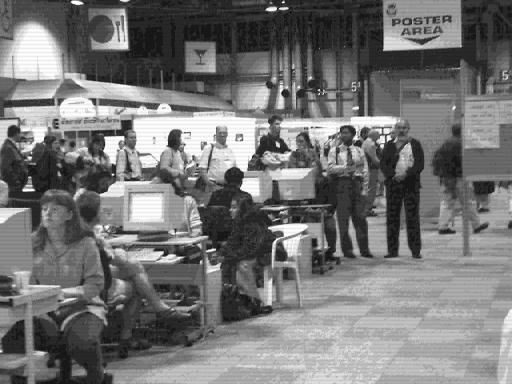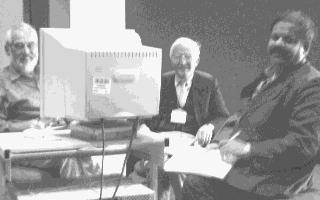Pages in this file are :
Report on the IUCr XVIII Glasgow 1999 Software Fayre
Throughout the entire IUCr XVIII in Glasgow, a Software Fayre was held to
allow both software authors and users to interact with the various freely
available packages useful to Crystallographers. Thanks to the generosity and
helpfulness of the organising committee, SGI and Compaq; especially Chris
Gilmore, Stuart Mackay and David Thom, the Fayre had access to 3 Silicon
Graphics O2s, 7 Compaq PCs (2 running Redhat Linux. 5 running Window95); as
well as an overhead computer projector for demonstrating software to larger
crowds. Software was installed off CD-ROMs since the computers could not be
connected to the Internet for download of software and patches.
 As the long queue on the Internet Cafe turned many a calm crystallographer
into a rampaging desperado needing an Internet fix;
the lack of
Internet access for the Software Fayre computers actually allowed a wide
range of crystallographic software to be demonstrated.
As the long queue on the Internet Cafe turned many a calm crystallographer
into a rampaging desperado needing an Internet fix;
the lack of
Internet access for the Software Fayre computers actually allowed a wide
range of crystallographic software to be demonstrated.
(photo taken by Lachlan Cranswick shows part of the queue at the
Internet Cafe in the Exhibition area )
Small Molecule Single Crystal Software:
A healthy variety of available small molecule single crystal solution and
refinement software was presented at the Fayre. These include: John Gallager
demonstrating the ORTEX for Windows single crystal suite (based
around Shelx for solution and refinement) (1)
(
Click here for list of referneces with live links)
; Syd Hall and Brian Skelton, the XTAL
single crystal solution and refinement suite running on UNIX and Windows(2);
Paul Mallinson and Thomas Richter, the "Project XD" Charge Density
Software(3); David Watkin and Richard Cooper the new GUI based
CRYSTALS refinement suite for Windows(4); Louis Farrugia the
WinGX for Windows suite (based around Shelxs, Sir and Dirdif for
solution and Shelxl for refinement)(5). Riccardo Spagna demonstrated the
combination of using Sir and CAOS (Crystal Analysis Operating
System)(6) to solve (Sir for direct methods(7), CAOS for Patterson methods)
and CAOS for refining structures; Michal Dusek, the JANA98 program
(UNIX and PC) for refinement of ordinary and modulated structures(8); Paul
and Gezina Beurskens the Patterson methods and difference direct methods
based DIRDIF structure solution package (UNIX and PC) (9). Rene de
Gelder showed how easy it is to compile and install the the direct methods
CRUNCH structure solution package under UNIX and Linux(10) for
handling difficult structures. Frantisek Pavelcik demonstrated the Patterson
methods based XFPA structure solution program (UNIX and PC) (11) and
Ton Spek the Platon/"System S" single crystal suite (UNIX/Linux)
(Shelxs, Sir, Dirdif and Crunch for structure solution, Shelxl for
refinement and powerful Platon tools)(12).

Paul Beurskens and company showing
great tolerance while being photographed by Lachlan Cranswick during an ad-hoc DIRDIF demonstration.
Powder Diffraction
Powder diffraction software demonstrations included: Robin Shirley on the
CRYSFIRE powder indexing suite(13) who successfully
indexed some Protein powder diffraction data provided by Bob von Dreele;
Armel Le Bail on solving structures from powder diffraction data using the
Monte Carlo based methods incorporated into the ESPOIR software(14);
and Juan Rodriguez-Carvajal showed the latest Fullprof Rietveld friendly
plugin, the "GFOURIER" Fourier Map generation and display
software(15). A variety of other powder diffraction software was available
for people to try out.

Photorealistic rendering of structures using the ORTEX
single crystal suite of programs
see URL
http://www.nuigalway.ie/cryst/
Protein/Macromolecular Crystallography:
On the protein side, software demonstrations included Pamela Williams on the
XtalView program for UNIX (fitting electron density maps and solving
structures by MIR and MAD software); Isabel Uzon applying
Shelxpro/Shelxl for refinement of protein structures(17) (with the
possibility of using XtalView to view the maps (16)); Marian Szebenyi, the
MacCHESS Software/GUI for processing protein crystallographic data
using DPS programs, mosflm, and some CCP4 programs(18); and a
demonstration of MICE (Molecular Sciences and Interaction
Environments)(19). Bob von Dreele showed GSAS in action which now
also uses powder diffraction refinement of Protein structures(20), with maps
and structure linking into the Swiss-PDB Viewer(21).
Databases, Structure Manipulation, Diffuse Scattering and
Educational Software:
Alan Hewat used one of the SGI O2s to demonstrate the web based ICSD
(Inorganic Crystal Structure Database)(22). A Linux machine was used for
a DISCUS diffuse scattering/ crystallographic teaching demonstration
by Thomas Proffen and Reinhard Neder(23). PowderCell for Windows(24)
and Cryscon for Windows(25) were shown as effective tools for dealing
with structure transformations, including classical phase transformations.
Miscellaneous:
The prize for the most impressive demonstration goes to a presently
anonymous 10 to 12 year old accompanying person who managed to successfully
hack one of the SGI O2 IRIX machines in around 30 to 60 seconds (the
approximate time I had my back turned) and figured out how to get the "Doom"
game (26) into action. An psuedo-formal booking on computer security
ended up as small impromptu demonstrations on securing crystallographic
servers; it was interesting to learn of the wide range of crystallographic
UNIX computers that been successfully compromised and burgled by hackers
(insecure Linux installations were the main culprit). Pages on installing
dual boot Windows/secure Redhat Linux(27) combinations and the more secure
FreeBSD(28) based UNIX operating system for Crystallographic information
serving are available on the CCP14 website(29).
Lessons learnt from the Fayre for anyone interested in organising any
such events in the future include:
- Due to the extremely busy conference schedule, multiple bookings by
software authors is more effective than just single bookings;
- If Internet access is possible, it is important to have "lockable"
Internet links to restrict inappropriate use;
- Computer Fayres are best located as close as possible to the Poster area
(as many of the programs were described or mentioned on the posters);
- Creating a local intranet connecting the software Fayre computers is
highly desirable to enable maximum flexibility for installing software and
enabling demonstrations of network based applications.
Most of
software mentioned above is available for download via the internet for
anyone to try out. The powder diffraction and single crystal software is
also mirrored (where possible) on the CCP14 website and its mirrors (http://www.ccp14.ac.uk).
Thus there is no excuse not to try some of these tools and check their suitability to assist in high quality crystallographic analysis.
Lachlan Cranswick
CCP14 (Collaborative Computation Project for Single Crystal and Powder Diffraction)
Daresbury Laboratory, Warrington, WA4 4AD U.K
Tel: +44-1925-603703 Fax: +44-1925-603124 E-mail: [email protected]
Editor's Note: There is not enough space for a list of references for this article here, they can be found on the BCA Web site, with live links to sites with more information about the individual software items. Look at URL :
http://bca.cryst.bbk.ac.uk/BCA/ed/progs/Fayr99.html
Schools' Crystal Growing Competition exhibit at IUCr99
The winning crystals of potash alum from two National schools' crystal
growing competitions were exhibited at the IUCr XVIII in Glasgow and judged
in an International event, according to the "modified Canadian Formula" (see
below). Six crystals from the UK (three each from primary and secondary
schools) and eight from Canada were included in the exhibit. Two experienced
crystallographers from a neutral country (the USA) acted as judges; Jenny
Glusker and Miriam Rossi awarded marks for five quality criteria (clarity,
form, occlusions, faces, edges) and their marks were combined with a mass
mark and normalized to give the appropriate rankings.
The crystal judged to be the overall winner was grown by Peter Solman and
Sam Ockham of St Bede's School, Redhill, Surrey. Other UK crystals came well
down the rankings; the greater experience of the Canadian crystal growers
showed, as they took seven of the next eight places. Each of the
participants who had a crystal displayed will receive a copy of the book
"Crystals and Crystal Growing" by Holden and Morrisson.
A TV crew recorded the event as part of a "docummercial" about
crystallography and the IUCr Congress in particular; this is a short
(roughly three minute) item which fits into the normal commercial slots
between the full-length documentaries on the Discovery channel. Screening
should take place early in the New Year.
Most of the UK crystals came from the South-East of England, where the
competition is well-established, but we are trying to interest other areas
despite ever-increasing demands for time for the National Curriculum. If you
are interested in raising awareness of the competition in your region,
please contact me by email ( [email protected]). Details of how to enter
next year's national event and some contact details for foreign competitions
can be found on:
http://www.mrc-lmb.cam.ac.uk/harry/crystal
The "Modified Canadian Formula" takes into account the fact that while it is
relatively easy to grow a large imperfect crystal, or a tiny (to all intents
and purposes) perfect crystal, to grow a large, good quality crystal is
quite difficult. Also, it is somewhat distressing to be given a negative
mark for a nice crystal with a mass of less than 1g, hence the "+1" in the
mass parts of the equation! Generally speaking, a large ugly beast will not
win at the expense of a moderately sized beauty.
The "modified" arises from the normalization for the different competitions
allowing different masses of starting material. For the record, here it is;
Score% = 100*{log10(mass+1.0)*quality}/{log10(MASS+1.0)*QUALITY}
where mass = mass of crystal in g
MASS = maximum mass of starting material allowed
quality = crystal quality, based on the five criteria above
QUALITY = maximum quality score possible.
Harry Powell, MRC Laboratory of Molecular Biology
Page last updated 16 Oct 1999
BCA Home page WebMaster
[email protected]
 Click here to return to BCA homepage
Click here to return to BCA homepage
 As the long queue on the Internet Cafe turned many a calm crystallographer
into a rampaging desperado needing an Internet fix;
the lack of
Internet access for the Software Fayre computers actually allowed a wide
range of crystallographic software to be demonstrated.
As the long queue on the Internet Cafe turned many a calm crystallographer
into a rampaging desperado needing an Internet fix;
the lack of
Internet access for the Software Fayre computers actually allowed a wide
range of crystallographic software to be demonstrated.


 Click here to return to BCA homepage
Click here to return to BCA homepage